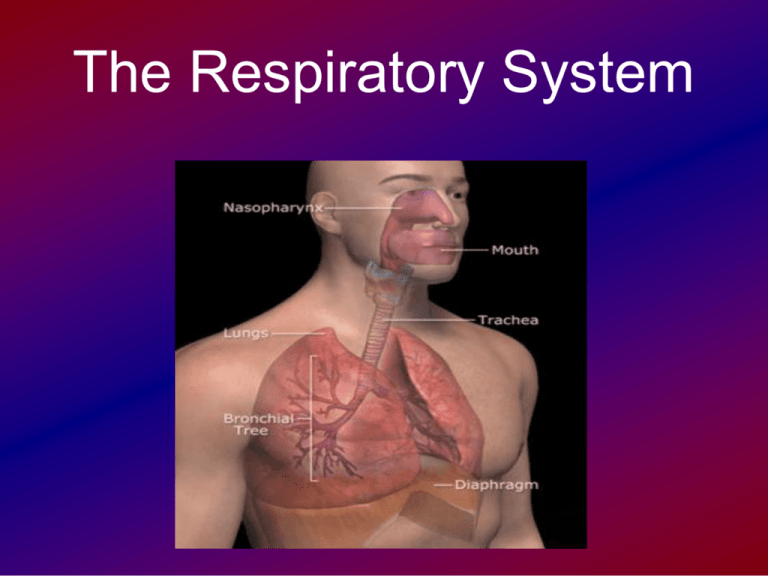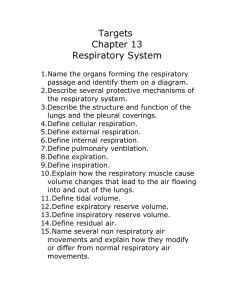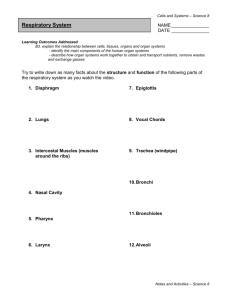The Respiratory System
advertisement

The Respiratory System 3 Main Functions Supply O2 to the blood Remove CO2 from blood Regulate blood pH (acid-base balance) External respiration: processes that occur within the lung involving the exchange of O2 and CO2 Internal respiration: exchange of gases at tissue level, O2 is delivered and CO2 is removed Cellular respiration: process where the cells use O2 to generate energy through the different metabolic pathways Respiratory System Structure Structures of the respiratory system can be divided into two main zones: Conductive zone Respiratory zone Conductive Zone Composed of all of the structures that convey air form the outside of the body through the lungs Includes: mouth and nose, pharynx, larynx, trachea, primary and secondary bronchi, tertiary bronchioles and terminal bronchioles Respiratory Zone Composed of respiratory bronchioles, alveolar ducts, and alveolar sacs All of these structures are involved with the exchange of gases between inspired air and the blood Alveolar sacs (alveoli) are grape-like structures that provide a large surface area for the diffusion of gases into and out of the blood Mechanisms of Breathing Movement of air from outside of the body to the inside of the body is dependent on differences in air pressure Air moves from regions of higher pressure to regions of lower pressure Diaphragm Diaphragm: large flat specialized muscle. With stimulation from the brain, it contracts and moves downward to create more space in the chest cavity. This results in a decline in air pressure within the chest and lungs With the contraction of the diaphragm, the air pressure within the chest cavity is lower than the air pressure outside the body This results in inspiration – air rushing into the lungs from outside Video http://www.youtube.com/watch?v=vu_ONM3Bj9 A&feature=related Ventilation Ventilation = the combination of inspiration and expiration The volume of air that is moved by the lungs in one minute Influenced by two factors: the volume of air in each breath, and the number of breaths taken Tidal Volume = the volume of air in each breath Respiratory Frequency = number of breaths taken per minute Adaptations to Training Regular aerobic training leads to very few adaptations in the respiratory system The only observable changes with training are in ventilation (combination of inspiration and expiration) Increase in tidal volume (Vt) and decrease in respiratory frequency (f) Respiratory Disease Asthma: spasm of the smooth muscle that lines the respiratory system Oversecretion of mucous Swelling of the cells lining the respiratory tract http://www.youtube.com/watch?v=qW2KL6TsF Ck&NR=1 COPD COPD: Chronic Obstructive Pulmonary Disease Describes a family of disease that lead to a dramatic reduction in airflow Differs from asthma in that the conditions persist and cannot be relieved as quickly or as effectively with medication People with COPD cannot perform everyday activities without experiencing dyspnea (laboured breathing)






